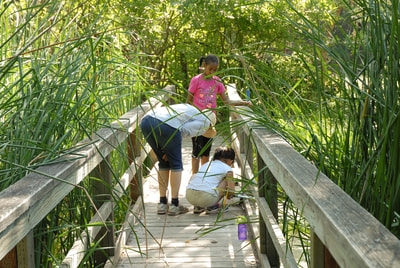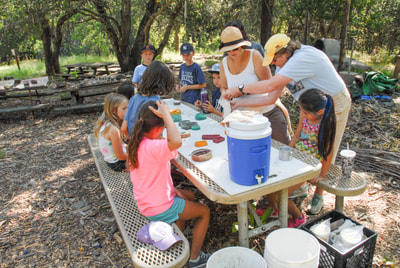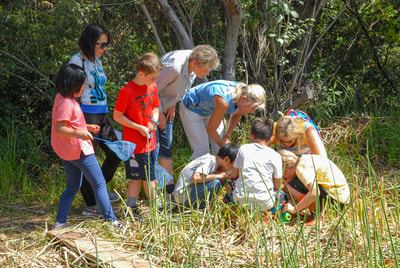Biodiversity Garden
The one-acre Wagner Ranch Nature Area Biodiversity Garden exemplifies the combined handiwork of thousands of children and adults over the past 15 years.
Children learn:
Parents and teachers learn:
Scout projects and memorials to Orinda children are other ways the Garden supports volunteerism and caring for others.
A Brief History of the Biodiversity Garden
In 1996, planning for the garden began. Lucy Hupp, Steve Gentry and erstwhile district naturalist, Toris Jaeger, discussed starting a garden in the Wagner Ranch Nature Area. It was our goal to create a multi-faceted learning center for children where there is great biodiversity of native species to catch the eye and stimulate the other senses. We sought to captivate all who come into the Nature Area and its garden to love what they see and want to preserve it. This corner of the Nature Area provides a place for native species of plants and animals, and organic practices to promote a diversity of beneficial insects to control the plant-eating insects without the need for pesticides and herbicides.
This WRNA garden was intended to be used by all students in the elementary schools, Orinda Intermediate School and Miramonte High School and even the Orinda community at large. We hoped that Lucy Hupp, Orindas first organic garden teacher, would mentor all of us in the garden, but with her passing that year, we decided to dedicate the garden to her. Steve celebrated his 50th birthday also that year and the grove of redwood trees was planted. Two of them are in the fenced area of the garden.
As soon as the Wagner Ranch School reopened in 1997, Toris Jaeger approached the principal, Helen Laird, to see if she and her teachers, students and parents would like to join the garden effort. Christine Hillsinger volunteered to work with Toris. They came up with a master plan that included a wheel-chair accessible trail, eight raised beds, a green house, and a pond. Teacher, Anne Morton, was especially active in getting support for the garden. Christine took a gardening class at the East Bay Regional Park Garden and met Ron and Rosemary Clendenen. Steve Gentry, Ron and Rosemary, Christine, Toris and other parents put in the trail and built the first eight raised beds and added a deer fence to protect the new garden beds.
In 1998, Ron and Rosemary Clendenen, teacher Daphne Kalmar and Toris planted the first native plants to enhance the Native American Studies program. They discovered that the native plants also needed protection from the deer, so the fence was extended to include an acre of the 18-acre Nature Area. They also dedicated a circle of redwood trees and a bench and rock to Peter Morton, Ann Morton's son who was killed in an auto accident. Anne insisted on using an historic bench from the 1970s. It was placed by the Peter Morton Memorial.
Over several years, Toris was successful in garnering volunteers and funds from the following groups: Orinda Garden Club, Orinda Rotary Club, the Orinda Parks and Recreation Foundation, Contra Costa County Solid Waste Authority (CCCSWA), East Bay Municipal Utility District (EBMUD), the Watershed Project, scouting groups and parent clubs. The Orinda Rotary Club took on raising funds for the pond and built it. Ron, Rosemary and Toris planted all the native plants in and around the frog pond. EBMUD gave us $5000 for irrigation and for the first native plants. CCSWA gave us $2500 for a shed, soil, compost, compost bins, and worm bins. From 1997 – 2002, Toris wrote six grants for the OUSD to the Watershed Project for $2500 each, (total of $15,000) for curriculum, tools, and science equipment. Ron and Rosemary Clendenen donated $10,000 for the removal of dying eucalyptus trees. Toris also spent $10,000 of her own funds for garden tools, curriculum materials, green house equipment, and the green shed.
The Orinda Garden Club led the fundraising efforts for the Greenhouse, helping to raise $40,000. The Crespis gave $14,000 for the greenhouse, and it was dedicated to Cynthia Crespi in 2000. Over the years, in addition to the greenhouse, the Orinda Garden Club has donated approximately $5000 to the garden for the Kid Shed and many of our power tools. Ron Clendenen built the propagation table and extra shelves for the greenhouse. In 2022, Orinda ONE donated $10,000 to help refurbish the greenhouse, construction planned for 2023-2024.
The Friends of the Wagner Ranch Nature Area is Launched
In 2000, Toris approached Dr. Frank Brunetti, Superintendent from 2000-2007, to formalize the ad hoc group of Nature Area volunteers into the Friends of the Wagner Ranch Nature Area. He did not give his permission until 2003, when volunteers established a mission statement, goals, and bylaws for the FWRNA under the fiscal umbrella of the East Bay Community Foundation. The founders of the FWRNA included: Theresa Slaman, Ron and Rosemary Clendenen, Steve Gentry, Reg and Kathy Barrett, Christy Blackie Taylor, Chris Jorgensen, and Toris. In 2008, board member and attorney, Kathryn Korn, assisted the FWRNA to gain legal status as a 501(c)(3) non-profit organization. .
From 2000 to 2002, Toris was working with Terry Slaman and other parents to help all of the schools develop biodiversity gardens for teaching science and mathematics. The National Wildlife Federation (NWF) singled out the Orinda Union School District for an award as the first district in the nation to have biodiversity gardens at every school. The award was presented by the NWF on May 18th, 2002 in the Nature Area Garden with hundreds of parents and children attending the celebration. That was the beginning of our annual Wildlife/Earth Day Festival, which has been held for the Orinda community every year since (until the pandemic in 2020-2022). At the invitation of the FWRNA, a team of scientists including Bob Stebbins, Steve Edwards, Bob Wisecarver, Reg Barrett, and Brian Murphy conducted a biological survey of the Nature Area and garden to recommend educational activities tied to the species of plants and animals. Bat houses were added to the garden at that time.
Christy Blackie Taylor and Rachel De Pavia were instrumental in getting parents throughout the District involved in the garden. Through their leadership, a renewed interest in the garden was achieved. Wagner Ranch parents donated $1500 to build 5 more raised beds. All the other beds in the garden were built by the FWRNA or from the Watershed grants for use by all schools in the District. .
In 2005, Toris assisted parent committees at the five schools to write successful grants to the State to fund all the school gardens at a level of $2500 per school. Christy and Toris were participants in the UC Botanical Garden's National Science Foundation Teacher Enhancement grant, which provided us with educational tools and resources for the Nature Area garden. Under the leadership of Jenny Maguire and Kathy Barrett, Christy and Toris conducted parent and teacher training to implement the Math in the Garden curriculum at all school gardens..
A major goal for the garden has been to promote and facilitate student projects. The following is a partial list of the inspired work of Orinda youth and members of the community:
Other Donations of Materials and People Power are as follows.
Sources: Documented by Toris Jaeger
Compiled by Lilana Spindler, August 16, 2015
Children learn:
- The use and botany of heirloom and native plants
- Horticulture techniques such as seed starts and propagating from cuttings.
- Composting, decomposition and soil health
- Recycling and reuse via the use of plant containers.
Parents and teachers learn:
- Techniques for gardening and composting at home.
- Math in the Garden, an extraordinary interdisciplinary program for teaching math in the garden.
Scout projects and memorials to Orinda children are other ways the Garden supports volunteerism and caring for others.
A Brief History of the Biodiversity Garden
In 1996, planning for the garden began. Lucy Hupp, Steve Gentry and erstwhile district naturalist, Toris Jaeger, discussed starting a garden in the Wagner Ranch Nature Area. It was our goal to create a multi-faceted learning center for children where there is great biodiversity of native species to catch the eye and stimulate the other senses. We sought to captivate all who come into the Nature Area and its garden to love what they see and want to preserve it. This corner of the Nature Area provides a place for native species of plants and animals, and organic practices to promote a diversity of beneficial insects to control the plant-eating insects without the need for pesticides and herbicides.
This WRNA garden was intended to be used by all students in the elementary schools, Orinda Intermediate School and Miramonte High School and even the Orinda community at large. We hoped that Lucy Hupp, Orindas first organic garden teacher, would mentor all of us in the garden, but with her passing that year, we decided to dedicate the garden to her. Steve celebrated his 50th birthday also that year and the grove of redwood trees was planted. Two of them are in the fenced area of the garden.
As soon as the Wagner Ranch School reopened in 1997, Toris Jaeger approached the principal, Helen Laird, to see if she and her teachers, students and parents would like to join the garden effort. Christine Hillsinger volunteered to work with Toris. They came up with a master plan that included a wheel-chair accessible trail, eight raised beds, a green house, and a pond. Teacher, Anne Morton, was especially active in getting support for the garden. Christine took a gardening class at the East Bay Regional Park Garden and met Ron and Rosemary Clendenen. Steve Gentry, Ron and Rosemary, Christine, Toris and other parents put in the trail and built the first eight raised beds and added a deer fence to protect the new garden beds.
In 1998, Ron and Rosemary Clendenen, teacher Daphne Kalmar and Toris planted the first native plants to enhance the Native American Studies program. They discovered that the native plants also needed protection from the deer, so the fence was extended to include an acre of the 18-acre Nature Area. They also dedicated a circle of redwood trees and a bench and rock to Peter Morton, Ann Morton's son who was killed in an auto accident. Anne insisted on using an historic bench from the 1970s. It was placed by the Peter Morton Memorial.
Over several years, Toris was successful in garnering volunteers and funds from the following groups: Orinda Garden Club, Orinda Rotary Club, the Orinda Parks and Recreation Foundation, Contra Costa County Solid Waste Authority (CCCSWA), East Bay Municipal Utility District (EBMUD), the Watershed Project, scouting groups and parent clubs. The Orinda Rotary Club took on raising funds for the pond and built it. Ron, Rosemary and Toris planted all the native plants in and around the frog pond. EBMUD gave us $5000 for irrigation and for the first native plants. CCSWA gave us $2500 for a shed, soil, compost, compost bins, and worm bins. From 1997 – 2002, Toris wrote six grants for the OUSD to the Watershed Project for $2500 each, (total of $15,000) for curriculum, tools, and science equipment. Ron and Rosemary Clendenen donated $10,000 for the removal of dying eucalyptus trees. Toris also spent $10,000 of her own funds for garden tools, curriculum materials, green house equipment, and the green shed.
The Orinda Garden Club led the fundraising efforts for the Greenhouse, helping to raise $40,000. The Crespis gave $14,000 for the greenhouse, and it was dedicated to Cynthia Crespi in 2000. Over the years, in addition to the greenhouse, the Orinda Garden Club has donated approximately $5000 to the garden for the Kid Shed and many of our power tools. Ron Clendenen built the propagation table and extra shelves for the greenhouse. In 2022, Orinda ONE donated $10,000 to help refurbish the greenhouse, construction planned for 2023-2024.
The Friends of the Wagner Ranch Nature Area is Launched
In 2000, Toris approached Dr. Frank Brunetti, Superintendent from 2000-2007, to formalize the ad hoc group of Nature Area volunteers into the Friends of the Wagner Ranch Nature Area. He did not give his permission until 2003, when volunteers established a mission statement, goals, and bylaws for the FWRNA under the fiscal umbrella of the East Bay Community Foundation. The founders of the FWRNA included: Theresa Slaman, Ron and Rosemary Clendenen, Steve Gentry, Reg and Kathy Barrett, Christy Blackie Taylor, Chris Jorgensen, and Toris. In 2008, board member and attorney, Kathryn Korn, assisted the FWRNA to gain legal status as a 501(c)(3) non-profit organization. .
From 2000 to 2002, Toris was working with Terry Slaman and other parents to help all of the schools develop biodiversity gardens for teaching science and mathematics. The National Wildlife Federation (NWF) singled out the Orinda Union School District for an award as the first district in the nation to have biodiversity gardens at every school. The award was presented by the NWF on May 18th, 2002 in the Nature Area Garden with hundreds of parents and children attending the celebration. That was the beginning of our annual Wildlife/Earth Day Festival, which has been held for the Orinda community every year since (until the pandemic in 2020-2022). At the invitation of the FWRNA, a team of scientists including Bob Stebbins, Steve Edwards, Bob Wisecarver, Reg Barrett, and Brian Murphy conducted a biological survey of the Nature Area and garden to recommend educational activities tied to the species of plants and animals. Bat houses were added to the garden at that time.
Christy Blackie Taylor and Rachel De Pavia were instrumental in getting parents throughout the District involved in the garden. Through their leadership, a renewed interest in the garden was achieved. Wagner Ranch parents donated $1500 to build 5 more raised beds. All the other beds in the garden were built by the FWRNA or from the Watershed grants for use by all schools in the District. .
In 2005, Toris assisted parent committees at the five schools to write successful grants to the State to fund all the school gardens at a level of $2500 per school. Christy and Toris were participants in the UC Botanical Garden's National Science Foundation Teacher Enhancement grant, which provided us with educational tools and resources for the Nature Area garden. Under the leadership of Jenny Maguire and Kathy Barrett, Christy and Toris conducted parent and teacher training to implement the Math in the Garden curriculum at all school gardens..
A major goal for the garden has been to promote and facilitate student projects. The following is a partial list of the inspired work of Orinda youth and members of the community:
- The circle of benches around the Valley Oak, in the center of garden, was a Girl Scout project of Erin Taylor.
- The four benches in the garden and the pond were the Eagle Scout project of Jayce Mental-Hecenthorn.
- The brick walk leading from the crushed granite path was the Eagle Scout project of Daniel Anderson.
- The two raised beds with the brick walk around them was the Eagle Scout project of Parker Etheredge.
- The deer fencing upgrade from rebar to 4×4 redwood posts was the Eagle Scout project of David Kasamitsu.
- The pond fence upgrade from rebar to 4×4 redwood posts was the Eagle Scout project of Drew Larson.
- The bell tower for the Cynthia Crespi donated bell was the Eagle Scout project of Michael Schier.
- Michael White installed the irrigation underground in the original eight beds for his Eagle Scout project. We have since tied into that line and brought more irrigation to the beds built by Wagner Ranch parents under Christy’s leadership.
- Bird houses were built by many Boy Scouts, including blue bird houses near the pond and trail.
- Jenny Papka built a kiosk for swallows across from the garden, and Toris donated two swallow houses.
- Neva Mills donated the bird house that survived Hurricane Katrina. There are two bird houses made from old mailboxes. All the houses have birds in them each spring.
- Fifth grade students have planted fruit trees each year as their gift to the garden as they leave for OIS.
- Most of the fruit trees were donated by Ken Murakami from the Moraga Garden Center.
- Fourth grade students have been taught how to grow native plants from seeds, nuts and cuttings. They have also planted many of the native species in the garden and throughout the WRNA, including the railroad tie beds built by students to host the plants for the insects and the birds.
Other Donations of Materials and People Power are as follows.
- Ro Dominguez donated his crew to build the rock wall around the greenhouse and the flagstone patio at the back of the greenhouse.
- The FWRNA purchased flag stone; Ron and Rosemary Clendenen and Toris obtained donation of and hauled volcanic stone for the greenhouse wall from the community center
- The planting containers have been brought by various people over the years and the bricks were also donated for projects in the garden.
- The FWRNA provided funds to rebuild the dining shelter and kitchen and for power in all the sheds.
- The Paper House, the Green Shed (that Toris purchased and had built) and the Yellow Shed (the adult shed) all have mason bee boxes and various bird houses attached.
Sources: Documented by Toris Jaeger
Compiled by Lilana Spindler, August 16, 2015





